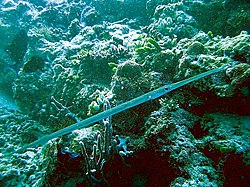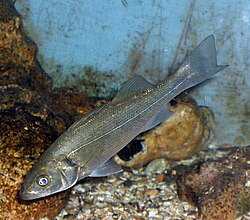Lessepsian migration


Lessepsian migration is the name given for the migration of marine species through the Suez Canal, between the Red Sea and the Mediterranean.
It is named after Ferdinand de Lesseps, who built the Suez Canal. The Suez Canal joined two biospheres that were separate before. Many species migrated from the Red Sea to the Eastern Mediterranean. Only a few species migrated in the other direction, from the Mediterranean to the Red Sea. The migration can be seen most clearly when looking at fish species, even though other animals also migrated.
When the Suez Canal was opened in 1869, it created the first salt-water passage between the Red Sea and the Mediterranean. The Bitter Lakes are two very salty (hypersaline) lakes about mid-way in the canal. At first, this blocked the migration of species from the Red Sea to the Mediterranean. Over the last decades, the salinity of the lakes changed, which made it easier for species to migrate.
The Red Sea is higher than the Mediterranean, at high tide, water flows from the Red Sea to the Mediterranean. The Red Sea is also poor in nutrients, so species who migrate will find more nutrients. The waters of the Red Sea are saltier than that of the Mediterranean. For these reasons, most species migrate from the Red Sea to the Mediterranean, and only very few migrate in the other direction.
When the Aswan High Dam was built in the 1960s, this blocked the flow of freshwater from the Nile into the Mediterranean. As a result, the salinity levels in the Eastern Mediterranean increase, and make it much more like the Red Sea – this means that migration will become even easier, as conditions are very similar.
Invasive species coming from the Red Sea and introduced into the Mediterranean by the construction of the canal have become a major component of the Mediterranean ecosystem. They have serious impacts on the Mediterranean ecology, endangering many local and endemic Mediterranean species. To this day, about 300 species native to the Red Sea have been identified in the Mediterranean Sea, and there are probably others still unidentified.
The Egyptian government announced it plans to deepen and widen the canal. This announcement has raised concerns from marine biologists, who fear that this will worsen the invasion of Red Sea species into the Mediterranean, and make the crossing of the canal easier for additional species.[1]
Today, the term Lessepsian migration is used more broadly for any migration of animals over man-made structures.
Lessepsian Migration Media
The Suez Canal, along which marine species migrate from the Red Sea to the Mediterranean Sea, in the original Lessepsian migration. The term is now more widely applied to migrations via any man-made structures.
Fistularia commersonii, a Lessepsian migrant
References
- ↑ Galil, B.S. and Zenetos, A. (2002). A sea change: exotics in the eastern Mediterranean Sea, in: Leppäkoski, E. et al. (2002). Invasive aquatic species of Europe: distribution, impacts and management. pp. 325–36.




